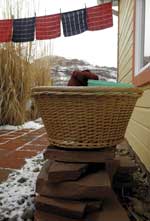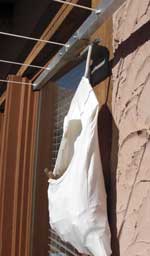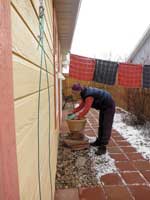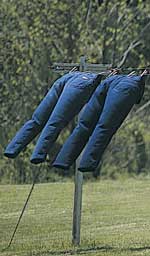Sustainable Happenings March 2011
Out on the Line
by Joan Gough
It is 1954. My mother and I are hanging out clothes on the backyard line. I pick a shirt out of the basket, shake it out and hand it up for her to pin to the line. I know she likes to keep the shirts together, the socks, sheets. I sense her satisfaction in doing this simple job well. Huge cumulus clouds drift overhead and a warm breeze stirs the drying sheets. This iconic memory with it’s sense of satisfaction is part of every load of laundry I hang out to dry.
Of course, there are also a number of more practical reasons to eliminate the middle machine and go directly to wind and solar power.

Photo by T. Pilcher |
One of those practical reasons is actually convenience. As one friend says, “I don’t have to manage the clothes, just throw them up and come back later.” They aren’t sitting in the dryer getting wrinkled, they are getting disinfected naturally by UV rays and scented with actual fresh air, not packaged “fresh scent.” My friend’s timetable of “later” could be as little as 45 minutes in Moab, but leaving them out over night is seldom a problem either.
For most of us, there is nothing more practical than saving money. Dryers cost more to operate than any other appliance in the home except perhaps the refrigerator. By eliminating the use of their dryer, a family of four can save as much as $25 a month, according to LaundryList.org.
To completely eliminate your dryer, you can use an indoor rack. The best one I’ve used is coated metal, cost $12, folds to two inches thick, and is amazingly efficient. There are also wooden racks and retractable lines which you can get from most department or hardware stores. When I mentioned the indoor rack to friends, several pointed out that drying clothes inside humidifies the house.

Photo by Joan Gough |
Due to a process called sublimation clothes dry in Moab, and most of the Mountain West, just fine even in the winter. When ice sublimates, it goes directly from a solid (ice) to a gas (water vapor) without turning to liquid in between. When I can no longer hear the Levi’s clinking together, I know they are ready to be brought in.
Once you have installed a sturdy outdoor clothes line, you will discover all sorts of other uses for it. My neighbor’s line has served as a grape arbor for some 30 years. As he says, “About half of the line in October will be laden with concord grapes and the other half with drying clothes.”

Photo by T. Pilcher |
In the summer my line is often festooned with drying tarps, life vests, even an inflatable kayak or raft drip drying after getting hosed off. That old fashioned idea of beating rugs works when you throw the rug over the line and hit it with a broom or baseball bat (more stress relief with the bat). Many of us have down comforters, which can benefit from a good airing on the line. The UV rays kill mites and bacteria and the air fluffs the down.
You will find there are many choices today for outdoor lines. On Amazon alone there are eight models of lines to choose from. One of the most ingenious lines I’ve seen was designed by a local woman. She attached plastic covered lines to her fence with ring bolts. Opposite them on her house, which is eight feet away, she screwed in another set of bolts and attached the line with a clip. When she is not drying clothes, she just clips both ends to the wall, and it is out of the way.
Other possible lines are on retractors--from single lines that you might put up in the bathroom to five-line rods suitable for the yard or garage. Another friend is very happy with her five-line retractable system which runs from her house to a T-post in the yard when pulled out and attached. It is completely out of the way when not in use.
 I use wooden clothes pins with metal springs and quarter inch nylon rope from the lumber yard. I suggest the nylon rope because it is durable, yet doesn’t get dirty like the twisted wire stands can. The plastic pins, while colorful, don’t hold up as well as the wooden ones. A clothes pin bag that you either wear or hang over the line saves your back. I use wooden clothes pins with metal springs and quarter inch nylon rope from the lumber yard. I suggest the nylon rope because it is durable, yet doesn’t get dirty like the twisted wire stands can. The plastic pins, while colorful, don’t hold up as well as the wooden ones. A clothes pin bag that you either wear or hang over the line saves your back.
Finally, you need a laundry basket. These, too, you can find in less back straining versions. A time saving idea is to use plastic hangers to hang your shirts and pants on. From the line they go directly into your closet.
If you want to dry your clothes outside and your homeowners association restricts it, you might look to LaundryList.org for help. Project Laundry List was formed a few years ago to encourage line drying in the Boston area, but quickly became a national phenomenon helping people deal with codes and covenants against clotheslines.
For me, like most of the people I’ve talked to who are avid line dryers, it isn’t only about money or being green--it is also about spending a few moments outside feeling the sun on my skin, the breeze in my hair, and enjoying the memory of Mom’s presence at my elbow. |



 I use wooden clothes pins with metal springs and quarter inch nylon rope from the lumber yard. I suggest the nylon rope because it is durable, yet doesn’t get dirty like the twisted wire stands can. The plastic pins, while colorful, don’t hold up as well as the wooden ones. A clothes pin bag that you either wear or hang over the line saves your back.
I use wooden clothes pins with metal springs and quarter inch nylon rope from the lumber yard. I suggest the nylon rope because it is durable, yet doesn’t get dirty like the twisted wire stands can. The plastic pins, while colorful, don’t hold up as well as the wooden ones. A clothes pin bag that you either wear or hang over the line saves your back.